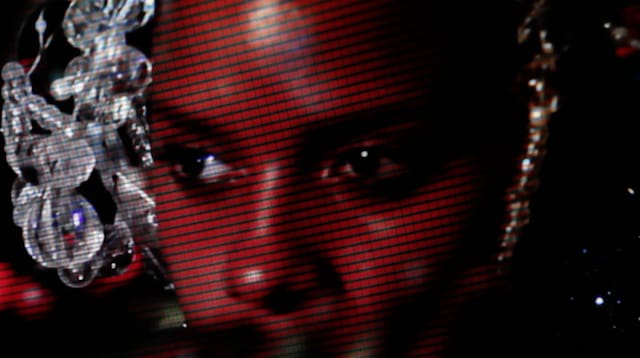Artist Collective Withdraws from Whitney Biennial
The Yams Collective, the largest of the eight collectives participating in the 2014 Whitney Biennial, has withdrawn over objections to the curatorial program, Hyperallergic has learned.

The Yams Collective, the largest of the eight collectives participating in the 2014 Whitney Biennial, has withdrawn over objections to the curatorial program, Hyperallergic has learned. The group, known in the Biennial as HOWDOYOUSAYYAMINAFRICAN?, was selected for inclusion by curator Michelle Grabner and presented a video piece titled “Good Stock on the Dimension Floor: An Opera.” They submitted their withdrawal to the Whitney yesterday, which Yams Collective member Maureen Catbagan said was driven by objections to the Biennial’s inclusion of Joe Scanlan’s “Donelle Woolford” piece, in which the white male Princeton professor hires black female actors to play the part of a fictional black artist named Donelle Woolford (the piece has been ongoing since 2005, according to the artist’s website).
“We felt that the representation of an established academic white man posing as a privileged African-American woman is problematic, even if he tries to hide it in an avatar’s mystique,” Catbagan said. “It kind of negates our presence there, our collaborative identity as representing the African diaspora.”
The piece has drawn objections from bloggers, artists, and activists, including a polemical critique by Eunsong Kim and Maya Isabella Mackrandilal publicly endorsed by another artist presenting at the Whitney Biennial, Pedro Vélez.
Catbagan stated that the group had reached out to Grabner over her inclusion of their work alongside Joe Scanlan’s and received what in her words was a “non-response.” The Whitney unsuccessfully attempted to mediate the situation, which culminated in the collective’s withdrawal yesterday.
Upon their inclusion in the Biennial, the New York Times profiled the group and its role in racial advocacy in the arts, interviewing the artist Sienna Shields, the collective’s instigator. “I’d go to art events, and I’d be the only black person in the room — here in New York. It was ridiculous: There’s all this vast talent. I thought of all the great people I’d known in my years in New York and I thought, ‘Let’s exert ourselves!’,” Shields told the Times.
An alternative screening of the film piece will take place on Thursday, Friday, and Saturday of next week, “a big event which will show it in a more appropriate way,” Catbagan said.
The Whitney Museum has not yet responded to a request for comment; we will update this space if and when we hear back.
Update, 6:12pm EST: The Whitney has offered Hyperallergic this statement:
While we understand and respect the decision of HOWDOYOUSAYYAMINAFRICAN?, we support all the artists in the Biennial and the curatorial choices of the exhibition’s three curators. The Whitney Biennial has always been a site for debate — no matter how contentious or difficult — of the most important issues confronting our culture.
We have also obtained a note sent by Joe Scanlan to all of the artists participating in the Whitney Biennial. It reads:
Dear Siena [sic],
I’m sorry to hear that HOWDOYOUSAYYAMEINAFRICAN has chosen to remove it’s work from the Biennial due to your finding the work of Donelle Woolford objectionable. I understand that the project is provocative and controversial, and I respect everyone’s right to react as they see fit for their own mind, their own body, and their own politics.
I only want to say that the experiences I have had working on Donelle Woolford have been some of the most intellectually challenging and humanly rewarding experiences of my life, largely because it has required me to confront what I don’t know, come to grips with those limits, and work at pushing them, expanding them. Not only as a white male artist, but as a human being. That confrontation, that learning experience, continues even now as I consider the weight and force of your actions.
I doubt I could change your mind about Donelle Woolford. But had you been witness to the years of rehearsals and discussions that Jennifer Kidwell, Abigail Ramsay, and I have engaged in — including the performance we are touring for the Biennial — I believe you would have a very different sense of the interpersonal relations involved, and the shared commitment that makes the narrative possible.
all the best,
Joe Scanlan
Scanlan’s above email was in response to the following message sent by Sienna Shields to the same group — all participating Whitney Biennial artists — at 5:09pm Tuesday, May 13:
While HOWDOYOUSAYYAMINAFRICAN? has appreciated the opportunity to screen the poem “Good Stock on the Dimension Floor” at the 2014 Whitney Biennial, we cannot, in good conscience, be further subjected to Michelle Grabner’s curatorial curriculum. Its defacto endorsement by the Whitney Museum is both insulting and troubling.
We’re sure that we don’t need to explain how the notion of a black artist being “willed into existence” and the use of a black FEMALE body through which a WHITE male “artist” conceptually masturbates in the context of an art exhibition presents a troubling model of the BLACK body and of conceptual RAPE. The possibility of this figure somehow producing increased “representation” for black artists both furthers the reduction of black personhood and insults the very notion of representation as a political or collective engagement.
What we stand for—
The Our in
collective
selves
mission
voices
together and individually refuses to participate in a fundamentally flawed curatorial process. We appreciate that the Whitney Museum has attempted to fashion an institutionally circumscribed bandaid. However, this is a wound that deeply penetrates the surface of ourskin.
We hope that the next Biennial will truly reflect the American voice. We cannot be placed in the position of condoning the current one.
We are removing our work from the 2014 Whitney Biennial.
HOWDOYOUSAYYAMINAFRICAN?
Update, 10:04pm EST: The Yams Collective has offered the following clarification with regard to the timing of their withdrawal ahead of the Biennial’s closure May 25:
We have had ongoing dialogue and discussions for several weeks regarding our concerns. Unfortunately, we feel the process wasn’t proactive enough and wasn’t producing results. While people may question our timing, our work was slated to begin showing in rotation today. To our critics who think this is convenient timing or a PR stunt, we say again, we’ve been discussing this for weeks. More important than the “game” of our collective is the larger issue of fair representation and exposure specially, when it concerns the very current question race within the cultural/artistic context. We did not create Danelle Wolford. But she exists and is institutionalized, so let us talk about it…




